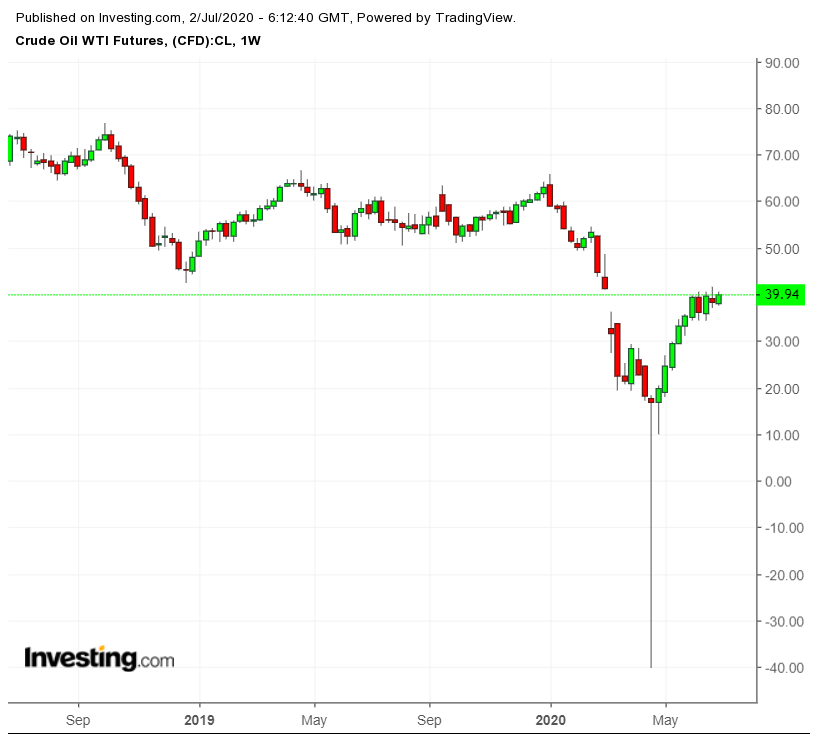As most of the world recovers from the coronavirus pandemic and enforced economic shutdowns, signs for the health of the oil market are mixed.
OPEC+ seems poised to ease its production cuts in the second half of the summer, although that’s not yet a done deal. And while offshore storage has dropped, the glut isn't necessarily gone. Adding to the conflicting picture: news about oil demand from countries like India and the United States is varied.
Optimists are happy, but pessimists have several data points on their side too. Below we take a deeper look at where the oil market stands:
1. Production To Rise In August
Last month OPEC extended its production cuts for July. Now July has arrived and market watchers are closely observing the group for August guidance.
Currently, signs point towards OPEC+ lifting production by about 2 million bpd between July and August. According to Reuters, several sources from OPEC+ confirmed the likelihood of such a production lift unless demand is particularly weak.
Both Saudi Arabia and Russia have signaled that they are satisfied with oil demand and/or prices. Amin Nasser, Saudi Aramco’s CEO, said on Tuesday that “the worst is behind us” and global oil demand has already returned to about 90 million bpd. This figure stood at around 100 million bpd prior to the pandemic and economic shutdowns.

Russian oil minister Alexander Novak holds that Russia is satisfied with current oil prices, and Kirill Dmitriev, the head of Russia’s sovereign wealth fund, stated he sees no point in extending the 9.7 million bpd cuts from OPEC+ past July.
However, it would be wise to prepare for a possible about face. If oil prices start to trend downward, either from rising production in the U.S. and elsewhere, or from weak demand numbers, OPEC could pressure Russia to agree to extend the 9.7 million bpd cuts for an additional month.
Regardless of where oil prices stand, it is highly unlikely that Russia will support any OPEC+ policy that does not permit it to increase production in August. Russia has experienced a boost in domestic demand for its Urals blend oil and has had to curb exports in July as a result.
In fact, it would not be surprising to see Russia start to raise production even before August 1 if domestic demand continues to grow.
2. Signs Global Demand Is Picking Up
Crude oil and petroleum products stored on tankers at sea have declined, indicating that demand is picking up as economic activity resumes.
According to estimates from IHS Markit, 180 million barrels of oil were being stored at sea at the end of April. That has declined to just under 150 million barrels at the end of June.
Refined products held on tankers reached a high of 75 million barrels in mid-May, but the numbers have now fallen to 50 million barrels. The shipping group NORDEN expects floating storage to reach “normal levels” at some point in the third quarter.
However, declines in floating storage don’t necessarily suggest that all of the crude oil and products are being consumed. In the spring it was significantly cheaper to store oil at sea than it was to store it on land (a situation known as contango). The incentives to store oil at sea have decreased since the spring, because it has become less expensive to store oil on land.
Fuel consumption in India continued to rise in June, while in April, it sunk by half, the lowest level since 2007.
Even with the recent growth, India’s oil demand is still 12% lower than last year at this time. However, the country’s oil minister said that if demand continues to rise at current rates, normal levels could return by September.
At the same time, the rate of economic growth dropped to only 3.1% in the first quarter. Given the economic situation, oil demand may not reach previous levels this year.
In addition, India’s fuel consumption numbers were helped by a government policy that provided free LPG (liquefied petroleum gas used for cooking) to 80 million poor households during India’s pandemic lockdown, a policy which may mask greater underlying economic problems that could continue to drag down Indian oil demand.
3. U.S. Consumption: A Bumpy Road Higher
Several weeks ago, the EIA forecast that oil demand in the U.S. would continue to climb steadily as economic restrictions were lifted. I cautioned against this assumption and warned to expect more bumps in the road.
Now evidence of those bumps is coming to light. EIA data revealed that gasoline stores increased last week by 1.2 million barrels. This was likely due to expanded refinery utilization (94% for the week ending June 28 compared to 73% the week prior) along with a slight decrease in demand for motor gasoline.
The greatest concern for U.S. demand is that high numbers of positive tests are leading some jurisdictions to heighten restrictions, which in turn lead many Americans to cut back economic activity. Although hospitalizations and particularly deaths appear to be down, fear of a virus resurgence is influencing the economy in ways we cannot yet measure.
